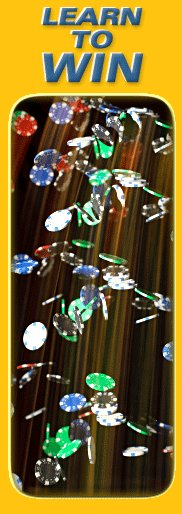Learn Baccarat Rules & Strategies: A Primer
by Frank Scoblete
If you have never played the game before, Learn Baccarat Rules & Strategies Primer is for you.
Baccarat Rules: Card Values
The game is dealt from an eight-deck shoe (sometimes six decks will be used). All tens, jacks, queens and kings equal zero. The ace equals one. All other cards equal their face value. Highest possible hand is nine. If you have two 5s, the total would not be a 10 but a zero.
Baccarat Rules: The Objective of the Game
The objective of the game is for the players to correctly guess which of three possible propositions will win on the next round: Bank, Player, or Tie. Two cards are dealt to the Bank hand and two cards are dealt to the Player hand. Sometimes a third card is dealt to either or both hands. Whichever hand is closest to nine is the winner.
A two-card hand of nine and a two-card hand of eight are considered naturals and do not take any hits. However, a two-card hand of nine beats a two-card hand of eight.
Baccarat Rules: Procedures
The deal goes counterclockwise around the table from player to player.
The player who is dealing continues to deal as long as the Bank hand keeps winning. However, as soon as a Player hand wins, the next player gets to deal. Thus, the shoe makes its way around the table. Players can pass up their turn at dealing if they so wish. If you want to play baccarat and you want to deal but you’re timid, don’t worry.
The casino personnel assigned to the baccarat tables are always willing to take you through the deals step by step. In the mini version, the dealer deals the hands.
After the Bank and Player hands have received two cards, it is possible that either or both might need to draw an extra card.
The baccarat rules for drawing cards are predetermined.
They are also essentially irrelevant since the players do not get to make any decisions concerning hitting or standing. Regardless of whether a card is drawn, at the end of the deal, the hand that totals nine or closer to nine wins.
Baccarat Rules: Payouts for Winning Hands
A winning Player hand is paid off at one to one.
Thus, if you bet ten dollars, you win ten dollars. A winning Bank hand is paid off at even money with a commission, usually five percent, extracted on each win.
This means that if you bet ten dollars, you win $9.50. This commission is collected after the shoe is finished but you can request to “pay as you go.”
If you are playing $25 or $75 per hand and are allowed to “pay as you go,” you might find that the casino will “drop the change,” (a winning $25 Bank bet should have $1.25 extracted, a winning $75 Bank bet should have $3.75 extracted but some casinos will just take $1 and $3 respectively in such cases) reducing the bank commission to four percent and the Bank’s house edge more than 50 percent. The Tie hand is paid at eight to one. Thus, a winning tie bet of $10 will return $80.
If you bet on either Bank or Player and the Tie wins, you do not lose your bet. It is a push.
The Casino Edge
The Tie bet is one of the worst bets in the casino, so let’s not even consider making it. Since the Tie bet does not affect the other two bets, Player and Bank, we’ll concentrate on how we arrive at the house edge for these bets.
The Player bet wins 49.32 percent of the time.
The Player bet loses 50.68 percent of the time.
Translate that into money and for every $100 wagered on the Player bet, you will lose $1.36. ($50.68 minus $49.32 equals $1.36.) The casino edge is therefore 1.36 percent.
The Bank bet wins 50.68 percent of the time.
The Bank bet loses 49.32 percent of the time.
Without any interference, the Bank bet would have a 1.36 percent edge in its favor.
If the casinos allowed this to stand, no one would bet Player and everyone would bet Bank until the casinos went bankrupt.
To avoid this, the casinos charge that five percent commission on all winning Bank bets. In actuality, you only win 95 cents on the dollar on a winning Bank wager as stated. This reverses the situation and gives the casino a smallish 1.17 percent edge.
How does a five percent commission reduce the edge to 1.17 percent?
When you lose the Bank bet, you lose $49.32 for every $100 wagered.
But, when you win the bet, you win $50.68 X .95 which comes out to $48.15.
Therefore, $49.32 minus $48.15 equals $1.17 lost per $100 dollars wagered. In short, a 1.17 percent edge for the casinos.
The Best Way to Play
I guess you can say that I am an old-fashioned stick-in-the-mud when it comes to playing this game. I say bet Bank only and, if you can afford it, do a “pay as you go” at $25 or $75 per round if the casino reduces that commission in its desire not to hand out change.
If you find that $25 (or $75) is too low a bet for the high-roller room, then you must play mini-baccarat. In that case, you are going to have to “con” yourself into making only 40 or so bets per hour to get the same game as you would at “maxi”.
You can do this by simply betting every third or fourth hand. Or you can do this following some kind of “anti-trend” or “trend” scheme.
An anti-trend scheme would see three Player decisions in a row occur before you place a Bank bet. A trend scheme would see two or three Bank bets hit in a row before placing a Bank bet. No matter what you do, reducing the number of decisions is the reason for doing it.
You might find that with comps or online bonus promotions, a reduced commission on the Bank bets and 40 decisions per hour, the casino’s actual “monetary” edge over you is nil.
In those circumstances, baccarat is as easy on you as hitting a wall at zero miles per hour!
Learn Baccarat Rules is followed by Tips
OR
How to Play Poker 1 Program
OR
Learn Poker Games 2 with 7 Game Types
Gambling Teachers Home
GT is attentive about getting the word out about our free programs, lessons and add-ons offered, however, we ask your assistance and consideration in promoting us.
Click link below that reads, "Enjoy this page? Please pay it forward. Here's how..." to add a link to your site, blog or personal page.
Tips, Terms & Wins
Chemin De Fer:
Other players can bet against all (banco), or any portion of the money. The highest bidder is then dealt the player hand.
There is no tie bet in this game, and no money changes hands when there is a tie.





